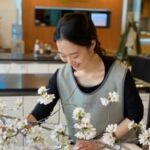How I Got to Love Kale: Kale Doenjang-guk
Cold days call for hearty, comforting soups. And with kale in season, there’s no better time to make Kale Doenjang-guk (케일 된장국), a Korean soybean paste soup that’s nourishing, simple, and full of deep, rich flavors. Give it a try!
A Kale Revelation
I didn’t always love kale. It was one of those greens I wasn’t sure what to do with—until I tried it in doenjang-guk. Unlike softer greens, kale keeps its texture in hot soup, giving each bite a satisfying chew. And when simmered in a savory and deep doenjang broth? Absolute perfection.
It reminded me a lot of Siraegi Doenjang-guk (시래기 된장국), made with dried radish tops, a winter specialty. Prepping siraegi (dried radish tops) takes up to around 10 hours because of the way it’s dried, so this kale version was a brilliant idea.
What Makes Kale Doenjang-guk So Special?
Doenjang-guk is a staple in Korean home cooking, made by simmering doenjang (Korean fermented soybean paste) in a light broth, usually with vegetables and tofu. The difference with Doenjang-jjigae is that it has lighter broth. Doenjang-jjigae is usually richer and more hearty, but Doenjang-guk is lighter making it more refreshing. It’s simple, comforting, and packed with gut-friendly prebiotics. Kale adds an extra hearty texture and a slight bitterness that balances beautifully with the umami-rich broth.
How to choose your kale

For the best texture and flavor, opt for smaller kale leaves, around 20-25 cm (⅔ ft) or less, as larger ones tend to be tougher and more fibrous. While pre-washed and pre-cut kale from the supermarket is convenient and can be used in this recipe, I recommend buying whole leaves whenever possible. They retain more of their natural texture and subtle nuttiness, making the soup even more enjoyable.
Key Ingredients
- Doenjang (된장, Korean fermented soybean paste): A fermented soybean paste that forms the backbone of this soup, giving it deep umami richness. Made from just soybeans, salt, and water, traditional doenjang is a by-product of making soy sauce and has a more complex, pungent flavor than Japanese miso. It’s a staple in Korean kitchens, used in everything from soups and stews to marinades, dipping sauces, and even salad dressings. Opt for artisanal or homemade ones but store bought ones are okay too.


- Kale: A sturdy winter green that holds up beautifully in hot broth without becoming mushy. In the Netherlands (where I live) and many other parts of the world, kale is at its peak in winter, making it an excellent seasonal choice. It brings a slightly bitter, earthy depth to the soup, similar to siraegi (dried radish greens), another classic ingredient in doenjang-guk.
- Tofu: Soft, delicate cubes of tofu soak up the flavorful broth, adding a satisfying protein boost.
- Anchovy-Kelp Broth: The classic Korean soup base that adds an extra layer of umami. If you prefer a vegan version, water or vegetable broth (with dried pyogo/shiitake mushroom and/or dried kelp) works well too.
Kale Doenjang-guk (Korean soybean paste soup with kale)
Equipment
- 1 stainless pot (around 2-2.5 liter by volume; half a gallon) any pots like cast iron pots (like Le Creuset or Staub pots) can be used
Ingredients
- 150 g kale (washed) around ⅓ lb.
- 3 cups anchovy kelp stock or water
- 2 ½ tablespoons doenjang (Korean fermented soybean paste) 2 tablespoons if you're using artisanal/homemade doenjang
- 100 g tofu
- 1 stalk green onion diagonally sliced
- a few slices of hot chili optional to add heat
- 1 teaspoon rice powder mix with 1 tablespoon water
- salt to taste if needed
For Anchovy kelp stock (3 cups)
- 3½ cup water
- 20 g dried anchovies
- 1 sheet dried kelp also known as kombu, dashima
Instructions
Anchovy kelp stock
- Add dried anchovies, dried kelp and water in a pot. Bring to a boil over medium high heat.

- When boiling, reduce the heat to medium low. Let it simmer for 3 minutes and take out the kelp. Keep simmering for 15 minutes and take out the anchovies.

Preparing the vegetables
- To trim the kale, tear the leaves off the stem with your hands. If the stem is tender enough to snap, it can be added to the soup too.

- Tear the leaves into smaller pieces.

- Thinly slice tofu into bite-sized pieces. Broth melts into these thin pieces making it extra soft and hearty.

Making the soup
- In a pot, add anchovy kelp stock in a pot. Add doenjang and stir well to break down the lumps. Bring to a boil over a high heat.

- When boiling, add kale and let it bring to a boil again. Reduce the heat to medium and boil until kale is softened (around 15 minutes)

- When kale has softened, add green onion, tofu. To add extra heat, add chili slices.

- In a small bowl, combine rice powder with water. Stir well and add it to the soup. This will slightly thicken the soup, making it more hearty and deeper in flavor. Give it a good stir. Let it boil for another 3 minutes. Salt to taste if needed.

- Serve together with a bowl of rice and kimchi to make a full meal.

Notes
Why You’ll Love This Recipe
- Deep, rich umami flavor: Doenjang (Korean fermented soybean paste) gives the broth a deep and satisfying taste.
- Hearty and nutritious: Packed with fiber, prebiotics, and plant-based protein.
- Perfect for winter: This soup brings warmth and comfort on chilly days. Try it with a bowl of rice and some kimchi.
- Similar to Siraegi-doenjang-guk (시래기 된장국): Just like the traditional version made with dried radish tops, this soup has a wonderful nuttiness and is my go-to during the colder months.
Enjoy Your Cozy Bowl
This soup is the ultimate winter comfort food. It pairs perfectly with a bowl of rice and a few simple banchan (Korean side dishes). If you’re new to Korean cooking or just looking for a new way to enjoy kale, this is a must-try!
Want to see it in action? Check out my YouTube video for a step-by-step guide!

![Kale Doenjang-guk (Soybean paste soup with kale) |케일 된장국 [Vegetarian] Kale Doenjang-guk (Soybean paste soup with kale) |케일 된장국 [Vegetarian]](https://i0.wp.com/123kimchi.com/wp-content/uploads/2025/01/Snapshot-31-01-2025-14_44-1.png?resize=750%2C500&ssl=1)




Thank you for another excellent article. Where else may just anyone get that type of information in such an ideal way of writing? I’ve a presentation next week, and I am at the look for such info.